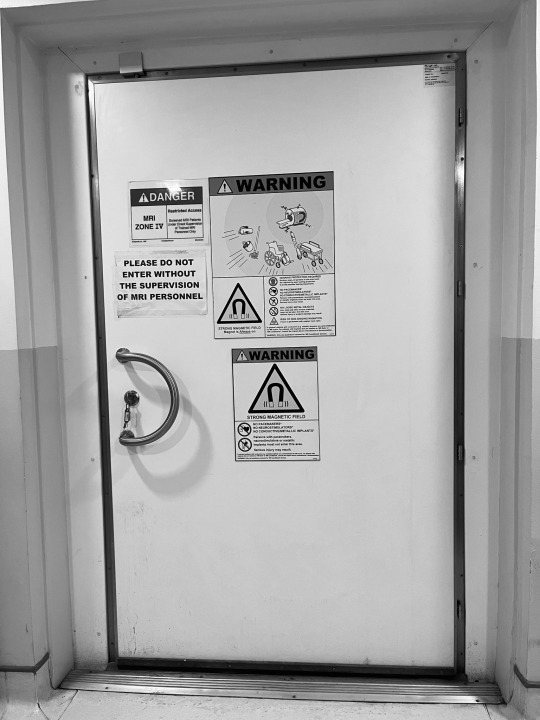#Magnetic Resonance Imaging
Text
By popular (???) request, based on the outcome of this poll.
A WARNING: you guys really did pick the most complex one. This is loooooong.
A DISCLAIMER. This is a silly little lesson aimed at folks who know sod-all about MRI. There are memes. There is (arguably) overuse of the term ‘big chungus’. If you are looking to delve deeper into the mysteries of K-Space, this is not the Tumblr post for you.
So, without further ado...
Today I am introducing you to my one true love. The legend. The icon.
Ferromagnetic material loves him. Claustrophobic people fear him.
Yeah, that’s right – we’re talking about the big boom-boom sexyboy magnet machine, hereby known as Big Chungus.

Aka...
MAGNETIC RESONANCE IMAGING
First off, though? Let’s start small.
Very, very small.
Meet HYDROGEN.

The nucleus of this element is made up of a single proton, which has a magnetic dipole – i.e., it acts like a tiny bar magnet.
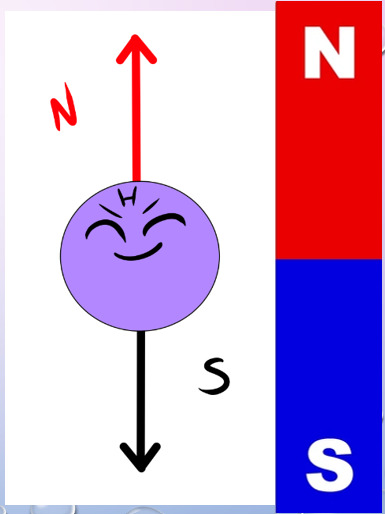
Hydrogen is also a component of water. As we all know, we’re basically walking sacks of goop – meaning that Hydrogen is abundant throughout our bodies.
Therefore, when we stick you in a strong magnetic field… say, within our friend Big Chungus… we can manipulate all those tiny Hydrogen atoms in a variety of fun ways.

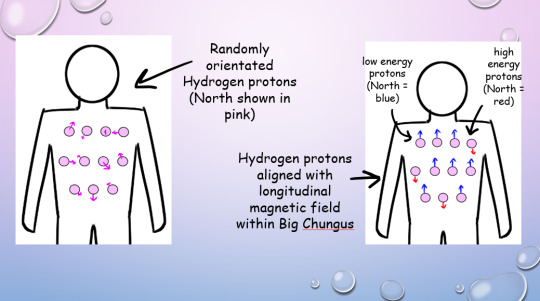
Under normal conditions, all your Hydrogen protons are pointing every-which-way.
But in Big Chungus, there is a strong longitudinal magnetic field that travels along the Z-axis of the machine. So, all your teeny tiny Hydrogen protons swivel to align with that field!
If a proton’s energy is LOWER than that of the longitudinal magnetic field (a majority), they will align PARALLEL with the field. If their energy is HIGHER (a minority) they will align ANTI-PARALLEL.
As most of the protons align with the longitudinal magnetic field, the net magnetisation vector within the human body is also longitudinal! This is called the thermodynamic equilibrium – the resting state for all those li’l protons when your body is within Big Chungus.
(You won’t feel any different, btw! We’re flipping a bunch of teeny-tiny bits inside you, but you won’t feel a thing!)
(You might do later, when we activate the Gradient coils. We’ll….. get to that)
But, while all of this is very cool, it gives us no actual information. We gotta play some more with your protons - which brings us to arguably the most important concept in MRI. I mean, it’s literally in the name!

Let’s go back to our Hydrogen protons.

We’ve established that they’re all pointing in different directions. But they’re not just sitting still. They’re spinning and wobbling all over the shop.
We call this rotational wobbly movement precession.
In their natural state, these protons all precess at different speeds. When we subject them to Big Chungus, as well as all lining up neatly with the magnetic field, they all start to precess at the same speed.
However, their magnetic North will be pointing to different points at any given moment. Imagine two clocks, both of which are ticking at the same rate, but which have been set to read different times.

This is where magnetic resonance comes in.
In addition to the homogenous longitudinal magnetic field provided by Big Chungus, we also create an oscillating magnetic field in the transverse plane by using a radiofrequency (RF) pulse. We can tune that oscillation to the ‘resonant frequency’ of Hydrogen atoms.
Every molecule capable of resonance has its own specific frequency. We use a funky equation called the Larmor Equation to work this out, or, as I like to call it, W, BOY!!!

(The weird ‘w’ is the resonance frequency; the weird ‘Bo’ is the magnetic field strength, and the weird ‘Y’ is the gyromagnetic ratio of each particular element.)
So, we know exactly at what frequency to apply that RF pulse to your protons, to achieve resonance!
But what is resonance?

In acoustics, a ‘resonant frequency’ is the frequency an external wave needs to be applied at in order to create the maximum amplitude of vibrations within the object. Like when opera singers shatter glass with their voice! They’re singing at the resonant frequency of the glass, which makes it vibrate to the point where it compromises its structural integrity.
A similar concept applies in magnetic precession, with, uh, less destructive results. We’re not exploding anything inside of you, don’t worry!
(We do explode your innards accidentally in Ultrasound sometimes, via a different mechanism. But you’ll have to ask me more about that later. >:3)
To put it simply, magnetic resonance is the final step in getting those protons to BEHAVE. Now, the clocks have been corrected so their hands move at exactly the same time, in the same position. The protons are precessing ‘in phase’. Yay!
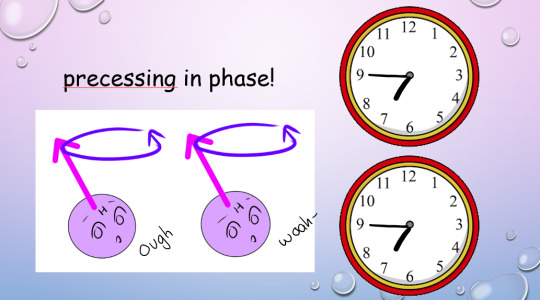
This creates transverse magnetisation, as the magnetic vectors of all those protons (which, remember, act as bar magnets) will swing around to point in one direction at the same time.
But the cool thing about resonance? It also allows the protons to absorb energy from the RF pulse.
(Do NOT ask me how. Do NOT. I will cry.)
And remember how the higher-energy protons flip anti-parallel to the longitudinal magnetic vector of Big Chungus, while the lower-energy protons are aligned parallel? And because we have more low-energy protons than high-energy protons, our body gains a longitudinal magnetic vector to match Big Chungus?
Zapping those protons at their resonant frequency gives 'em energy (a process known as ‘excitation’, which I love, because I get to imagine them putting little party hats on and having a rave).
So, loads of them flip anti-parallel! Enough to cancel out the net longitudinal magnetic vector of our bodies – despite the best efforts of good ol’ Chungus!
(Keep trying, Chungus. We love you.)

Our protons are as far from our happy equilibrium as they can possibly be. We’ve lost longitudinal magnetisation, and gained transverse magnetisation. Oh noooo however can we fix this ohhhh noooooo
Simple. We turn off the RF pulse.
Everything returns to that sweet, sweet thermodynamic equilibrium.
Longitudinal magnetisation is regained. I.e., the protons realign with Big Chungus’s longitudinal magnetic field, with the majority aligned parallel rather than anti-parallel.
This is called SPIN-LATTICE RELAXATION.
‘T1 time’ is the point by which 63% of longitudinal magnetisation has been regained after application of the RF pulse. A T1-weighted image shows the difference between T1 relaxation times of different tissues.
And, without that oscillating RF pulse, we lose resonance – the protons fall out of phase randomly, due to the delightful unpredictable nature of entropy, and Transverse magnetisation reduces.
This is called SPIN-SPIN RELAXATION.
Or, if we’re feeling dramatic…

‘T2 time’ is the point by which 37% of the transverse magnetisation has been lost. A T2-weighted image shows the difference between T2 relaxation times of different tissues.
(Spin-spin is objectively a hilarious phrase to say in full seriousness when surrounded by important physics-y people. However, a word to the wise: do not make a moon-moon joke. They are not on Tumblr (present company excluded). They will not understand. You will get strange looks.)

But remember how resonance lets our protons shlorp up that sweet, sweet energy from the RF pulse? Well, in order to get back to thermodynamic equilibrium and line up with Big Chungus again, they have to splort that energy back out.
This is why we stick a cage over the body part we’re imaging. That cage isn’t a magnet, or a way of keeping you still – it’s a receiver coil.
It picks up the RF signal that’s given off by your innards as they relax from the intense work-out we just put them through. How cool is that??
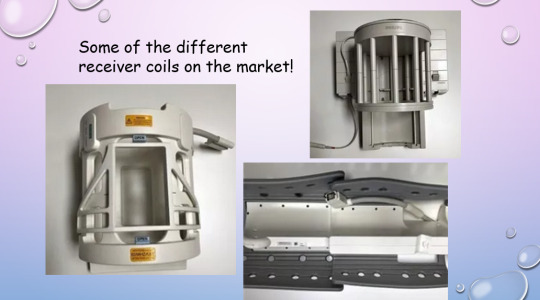
The amount of time we wait between applying the RF pulse and measuring the ‘echo’ from within your body is called the ‘ECHO TIME’, or ‘TE’ (because we didn’t want to call it ET).
(yes, we’re cowards. Sorry.)
We also have ‘REPETITION TIME’ or ‘TR’ – the amount of time we leave between RF pulses! This determines how much longitudinal magnetisation can recover between each pulse.

By manipulating TE and TR, we can alter the contrast (i.e., the blacks and whites) on our image.
Areas of high received signal (hyperintense) are shown as white, while areas of low received signal (hypointense) are shown as black. Different sorts of tissue will have different ratios of Hydrogen-to-other-shit, and different densities of Hydrogen-and-other-shit – ergo, some tissue blasts out all of its stored energy SUPER QUICK. Others give it off slower.
A T1-weighted image has a short TR and TE time.
Fat realigns its longitudinal magnetisation with Big Chungus SUPER QUICK. This means, on a T1-weighted image, it looks hyperintense. However, water realigns its longitudinal magnetisation with Big Chungus slooooowly. Therefore, on a T1-weighted image, fluid looks hypointense! Ya see?
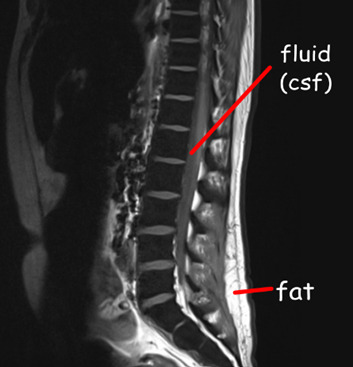
A T2-weighted image has a long TR and TE time.
The precession of protons in fat decays relatively slow, so it will look quite bright on a T2-scan. But water decays slower, and therefore, by the time we take the T2 image, fluids within the body will be giving off comparatively ‘more’ signal than fat – meaning they’ll appear more hyperintense!
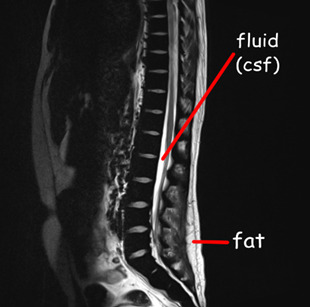
If we have a substance with intrinsically long T1 and T2 values, it will appear dark on a T1-weighted image and bright on a T2-weighted image, and the same in reverse. If a substance has a short T1 value and a long T2 value, it will appear relatively ‘bright’ on both T1 and T2-weighted images – i.e., fat and intervertebral discs.
As every tissue has its own distinct T1 and T2 property… we can work out precisely what sort of tissue we’re looking at.
When we build in all our additional sequences, this becomes even clearer! This is why your MRI scan takes sooooo long – we’re running SO MANY sequences, manipulating TR and TE to determine the exact T1 and T2 properties of various tissues within your bod.


There is, however, a problem.
The RF signal given off by each proton doesn’t shoot out in a handy-dandy straight line. Meaning, we have no idea where the signal is coming from within your body.
Enter our lord and saviour:
THE GRADIENT COILS.
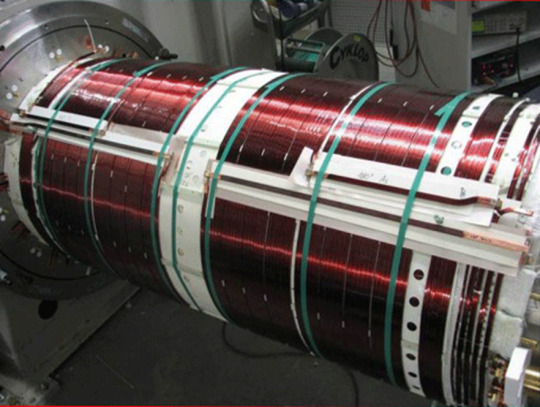
(Shim coils are also very important – they maintain field homogeneity across the whole of Big Chungus. While Big Chungus wouldn’t need them in a perfect theoretical scenario… reality ain’t that. Big Chungus’s magnetic field is all wibbly-wobbly, so we use Shims to keep everything smooth! That’s all you need to know about them. BACK TO THE GRADIENTS.)
There are three of them, wrapping around each of the three planes of your body. When these activate, they cause those epicly eerie booming noises, characteristic of a Big Chungus ExperienceTM.
youtube
The Gradient coils are also what causes those weird tingling sensations you get in an MRI machine – which, don’t worry, aren’t permanent! Your nerves just go ‘WOAHG. THASSALOT OF MAGNET SHIT. HM. DON’T LIKE THAT.’ But they’ll calm down again once you’re freed from Big Chungus.
The gradient coils cause constant fluctuations in the magnetic field across all three dimensions. They activate sequentially, isolating one chunk of your body after the next.
As these fluctuations cause variation within the signal received, we can look at how much THAT particular signal, received at THAT particular number of milliseconds after an RF pulse, varied when THAT particular gradient was activated, in comparison to when THAT OTHER gradient was activated.
For every single bit of signal output.
That gives us A WHOLE LOTTA DATA.

^ imagine this, but the cupboard contents is just. data.
Way too much data, in fact, for our puny human brains to comprehend – so obviously, we feed it to an algorithm.
K-space is a funky computational matrix where all this info gets compiled during data acquisition. Once we’ve finished the scan sequence and have all that yummy raw data, it can be mathematically processed to create a final image!
Just like that. Simple, right?

TL;DR
You are full of Hydrogen.
Hydrogen nuclei (protons) are basically tiny magnets
These tiny magnets are orientated completely randomly, with ‘North’ pointing in all directions
We stick billions of these tiny magnets (i.e., you) into a mahoosive magnet (i.e., Big Chungus)
All the tiny magnets flip around to align with the longitudinal magnetic field of Big Chungus
High energy protons = antiparallel
Low energy protons = parallel
As you have more low energy protons than high energy protons in your body, the net magnetic vector of your body is longitudinal – just like Big Chungus!
All your protons are spinning and wobbling (precessing) at random rates
We use an RF pulse, tuned to the Resonance Frequency of Hydrogen, to make ‘em precess in phase (wobble at the same time, all pointing in the same direction at once). This creates a Transverse magnetic vector.
This in-phase precession is ‘Magnetic Resonance’
Magnetic Resonance means the protons can absorb energy from the RF pulse
Now there are more high energy protons within your body! They flip antiparallel, and the net longitudinal magnetic vector of your body decreases.
We measure the time it takes for the high-energy protons to release that energy and return to alignment with the net magnetic vector of Big Chungus (Spin-Lattice Relaxation / T1 recovery)
And the time it takes for the precessing-in-phase protons to Quit That Nonsense and all start wobbling in random directions again (Spin-Spin Decay / T2 recovery)
Each tissue within your body has a different composition & density of Hydrogen atoms – which means each tissue within your body has a unique T1 & T2 recovery time
By measuring the signal at different times (TE) and by varying the frequency with which we apply RF pulses (TR), we ‘take pictures’ that show variations in the amount of signal these tissues are giving off. The signal is caught by the large radiofrequency receiver coils we put over you when you enter the machine.
Because the signal given off during recovery/decay blasts out in all directions, we don’t know exactly where it originated within your body.
Gradient coils are arranged across X, Y, and Z axes throughout the gantry of Big Chungus. They cause tiny fluctuations in the magnetic field, in sequential chunks throughout space. This is the booming noise you hear when you’re in the machine.
These tiny fluctuations cause variations in the signal we receive, depending on how close the signal is to the activated gradient coil. All this data is compiled in a magical computational matrix called K-space. A funky algorithm then decodes those variations and couples them up with the strength of the signal to give us
1) How much signal is being blasted out at that particular moment
2) Where exactly that signal comes from within your body, according to the 3D map produced by the gradient coils
It then represents these values with a pretty picture!
Tl;dr tl;dr:

45 notes
·
View notes
Text
The biggest mystery in the XMCU isn't how Darwin managed to die in First Class, but how Wolverine survived being put in what is essentially a big, magnetic tube without his skeleton getting ripped from his body.

#wolverine#xmen#x men movies#hugh jackman#mri#Mris are just giant magnets#magnetic resonance imaging#Marvel explain#Is it a magic mri machine?#How did the machine not explode?#You can't have metal in an MRI#i'm loosing my mind
17 notes
·
View notes
Text
“I love not being able to understand anything I’m seeing, thank you, Magnetic Resonance!”
14 notes
·
View notes
Text
Day 70: Mouse tractography

link
–This image is part of the public domain, meaning you can do anything you want with it ! (you could even sell it as a shirt, poster or whatever)–
#art#copyright#free art#open source#public domain#biology#flickblr#flickr#colorful#mouse#magnetic resonance imaging#neuroscience#science#non art#album cover material
5 notes
·
View notes
Text
MRI tomorrow. I'm so scared and nervous, I know nothing bad is gonna happen, it's just so scary
Wish me luck guys
8 notes
·
View notes
Text

Next Generation Images
A new 7 Tesla ultra-high resolution MRI scanner takes human neuroscience imaging to the next level
Read the published research article here
Erwin Hahn 7T MRI Laboratory, Henry H. Wheeler Brain Imaging Center, Helen Wills Neuroscience Institute, University of California, Berkeley, Berkeley, CA, USA
Image originally published with a Creative Commons Attribution 4.0 International (CC BY 4.0)
Published in Nature Methods, November 2023
You can also follow BPoD on Instagram, Twitter and Facebook
#science#biomedicine#neuroscience#biology#mri scan#mri#magnetic resonance imaging#medical imaging#next generation#brains#brain scan
7 notes
·
View notes
Text
*activates MRI machine*
“Commence primary ignition!”
#dougie rambles#personal stuff#mri scan#MRI machine#cat scan#magnetic resonance imaging#medical imaging#radiology#biomagnetics#no context#my poor attempt at a joke#what#this sounded funnier in my head#shitpost#weaponised#radiation#this kills the man#star wars#death star
4 notes
·
View notes
Text

This is an image derived while doing reconstructions of an MR neurography 3D dataset (displaying vessels highlighted by contrast medium, among other features).
I love the details and its overall aesthetics, though such images don't aid in the diagnosis. Just a little eyecatcher :)
#VeluVerse#Everyday life#MRI#Magnetic Resonance Imaging#Siemens#Siemens Magnetom Skyra#3 Tesla Scanner
3 notes
·
View notes
Photo

Scientists present a new method for imaging individual electrons
Imagine going for an MRI scan of your knee. This scan measures the density of water molecules present in your knee, at a resolution of about one cubic millimeter—which is great for determining whether, for example, a meniscus in the knee is torn. But what if you need to investigate the structural data of a single molecule that's five cubic nanometers, or about 10 trillion times smaller than the best resolution current MRI scanners are capable of producing?
That's the goal for Dr. Amit Finkler of the Weizmann Institute of Science's Chemical and Biological Physics Department. In a recent study, Finkler, Ph.D. student Dan Yudilevich and their collaborators from the University of Stuttgart, Germany, have managed to take a giant step in that direction, demonstrating a novel method for imaging individual electrons. The method, now in its initial stages, might one day be applicable to imaging various kinds of molecules, which could revolutionize the development of pharmaceuticals and the characterization of quantum materials.
Current magnetic resonance imaging (MRI) techniques have been instrumental in diagnosing a vast array of illnesses for decades, but while the technology has been groundbreaking for countless lives, there are some underlying issues that remain to be resolved. For example, MRI readout efficiency is very low, requiring a sample size of hundreds of billions of water molecules—if not more—in order to function. The side effect of that inefficiency is that the output is then averaged. For most diagnostic procedures, the averaging is optimal, but when you average out so many different components, some detail is lost—possibly concealing important processes that are happening on a smaller scale.
Read more.
13 notes
·
View notes
Text
Tips from the MRI:
I've just had my 19th MRI of the year (yes, this year of 2022 lol) and I have some tips that you won't get online or from your doctor for anyone feeling nervous about it.
- Try not to move (but accept that you will move and forgive yourself). If you are getting an MRI anywhere from the thoracic spine upwards, make sure to limit swallowing. If you have to sneeze or cough, let them know. Top tip, I find that I move more with my eyes closed than my eyes open. The best thing to do is distract yourself by thinking of something else. If you think about not moving, you will move more.
- You can customize your experience however you want. If you want them to check in with you every 10 minutes over the speaker, they will do it for you ( I find that this helps get an idea of how much time is going by). If you want wedges to prop up your arms, ask. If the pads holding your head in place are too tight, ask for smaller ones. You will be lying still for at least 30 minutes up to 2 hours, so make sure you're as physically and mentally comfortable as possible.
- For first timers, make sure you know what makes you comfortable before you go. Lying flat for a long time is fine. Lying flat and completely still is a different thing. If youre worried, you can practice beforehand by lying completely still on a flat, hard surface for 30 minutes and placing pillows where it feels comfortable (under the legs and/or arms, etc.). I always ask for wedges for my arms so I can fold my hands over my belly. I also ask for a blanket to cover my legs and for the staff to speak to me approximately every ten minutes. I tell them which vein I would like my IV in as well.
- If your MRI is longer than an hour, you might overheat. You might notice that the room with the machine is super cold. That's because the magnetic energy it produces when running for a long produces a lot of heat. Sometimes this heat is absorbed by the body and can actually sometimes raise the body temp up to 2 degrees Celsius. They keep track of the room temperature, but if you start overheating, let them know.
- You can ask to be sedated if you're claustrophobic. I've never needed to which leads me to my next point:
-The fear of claustrophobia can be avoided ( for those not typically fearful of this). I've learned two things from the MRI: fear and a large part of pain is all in the mind. If you imagine yourself trapped in a loud, coffin-like tube, then you will be very uncomfortable. If you close your eyes and imagine you're in your room on your bed, then you can relax a little. Here are some other scenarios I like to imagine: I'm the goth veraion of a vampire (get it cause the room is white instead of black lol) chilling in my coffin, I'm one of the Apollo 11 crew heading back home to Earth after having seen some pretty cool moonrocks, I'm a spelunker during am earthquake, I'm the first human to listen to an alien symphony, and plenty others.
- Learn the lyrics/tunes of the following songs: 9 to 5 by Dolly Parton, the William Tell overture, and TikTok by Kesha. It will make sense with all the noises of the machine.
-If you have contrast dye be careful getting up when you are done. Some of the side effects include dizziness, nausea, and mild headache.
- Have fun! Life is short and can be scary when you're sick. An MRI is a relatively short experience in the long term of your life and we should not try and dread these experiences. Today I met a man getting an MRI to check up on his brain tumour. We were chatting about how we were on clinical trials and how if we weren't born today and experiencing the beauty of modern science he would be dead and I would be blind. An MRI scan is a gift that not everyone can experience or access. Replace dread with joy and fear with wonder and you will have a much better time both in and out of the machine.
2 notes
·
View notes
Text
youtube
Philips MRI and GE MRI Differences: User Interface GUI
0 notes
Text
youtube
Nyello! I'm B.L.Radley, also known as @radley-writes, also known as 'that person who decided to become a radiographer on a whim literally so they could introduce themselves as Rad the Rad but then got really fucking obsessed with radiography and ology and now wants to commit themselves to several more years of specialised study and student debts to become an Advanced Practitioner in.... MRI, probably, but who the fuck knows'
Important info:
They/it/xe pronouns plz.
'Rad' on this blog refers ONLY to radiographers and surfer-slang. Transphobes begone.
I am a student.
This means:
I am not an expert! I might be wrong about stuff! If you know more than me, please feel free to correct me! I love this topic and want to learn more!
I am not qualified to give out medical advice, and will only say 'go see your doctor if this concerns you!' on this blog.
It's also worth noting that, though I do work part-time in a hospital, doin' the ol' radiography, I am not going to provide funny/embarrassing patient stories. Or any patient stories at all, beyond, perhaps, very, very anonymised anecdotes to help illustrate points. I strongly disagree with mocking patients or posting anything about them without their consent - particularly if it could be traced back to them! This is just a blog where I can scream excitedly about how cool it is that I can look at all the Mushy And Bony Stuff inside you without cutting you open!
(Although sometimes you'll get cut open too <3 Just for funsies <3)
Please feel free to ask me anything, and I will do my best to reply!
Or, uh. Infodump about my hyperfixation. Not sorry.
#radiography#radiology#medblr#studyblr#x ray#mri#ct#computed tomography#magnetic resonance imaging#cath lab funsies
12 notes
·
View notes
Text
Understanding Magnetic Resonance Imaging (MRI): A Guide to the Powerful Diagnostic Tool
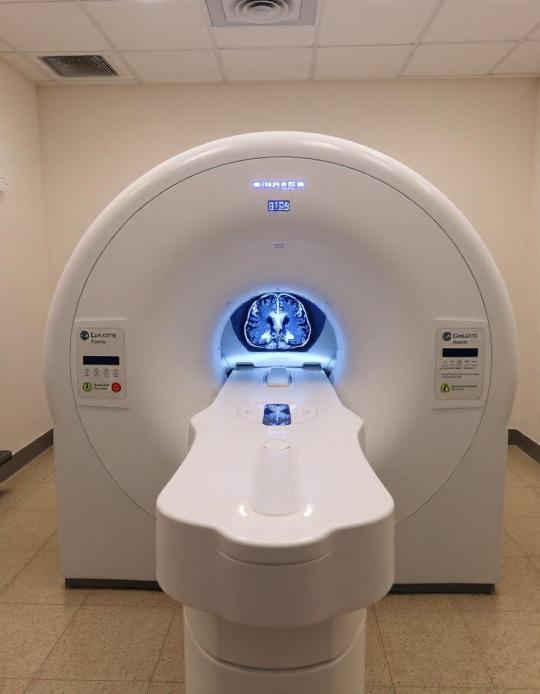
Magnetic Resonance Imaging (MRI) is one of the most advanced and widely used imaging technologies in modern medicine. It plays a crucial role in diagnosing a variety of medical conditions, allowing healthcare providers to view detailed images of the inside of the body without the need for invasive procedures. Whether it's for detecting abnormalities in the brain, spine, joints, or internal organs, MRI provides a clear and precise picture, guiding physicians in making informed decisions.
How MRI Works
MRI uses strong magnetic fields and radio waves to generate detailed images of organs, tissues, and structures within the body. Unlike X-rays or CT scans, which use ionizing radiation, MRI relies on the magnetic properties of atoms, particularly hydrogen, which is abundant in the body's water and fat molecules. The process involves aligning the hydrogen atoms using a powerful magnet, then disrupting that alignment with radio waves. As the atoms return to their normal state, they emit signals that are captured and converted into highly detailed images by the MRI machine.
Key Uses of MRI
MRI is an incredibly versatile diagnostic tool and can be used for a wide range of medical applications, including:
Brain and Nervous System: MRI is often used to diagnose conditions such as brain tumors, strokes, aneurysms, multiple sclerosis, and spinal cord injuries.
Musculoskeletal System: For injuries or conditions involving muscles, ligaments, and joints, MRI provides a clear view of soft tissues, helping in the diagnosis of torn ligaments, cartilage damage, and bone infections.
Cardiovascular System: MRI can provide detailed images of the heart and blood vessels, assisting in the diagnosis of heart disease, damaged heart tissue, or issues with blood flow.
Abdominal and Pelvic Organs: MRI is commonly used to examine organs such as the liver, kidneys, pancreas, and reproductive organs, identifying issues like tumors, infections, or abnormalities.
Benefits of MRI
Non-invasive: MRI is a painless and non-invasive procedure, making it a safe option for patients.
Detailed Images: MRI offers superior image clarity, especially for soft tissues, providing more detailed information than other imaging techniques.
No Radiation Exposure: MRI does not use harmful ionizing radiation, making it a safer option for repeated use, especially for sensitive populations like children or pregnant women.
Preparing for an MRI
While MRI is a safe procedure, there are a few important considerations:
Metal Objects: Because of the strong magnetic field, patients must remove all metal objects before the scan. Those with metal implants, pacemakers, or certain medical devices may need to consult their doctor before undergoing an MRI.
Claustrophobia: Some patients may feel claustrophobic in the enclosed MRI machine. Open MRI scanners are available in some facilities, and doctors can provide sedation if needed.
Contrast Agents: In some cases, a contrast agent may be injected to enhance the visibility of certain tissues. While generally safe, patients with kidney issues or allergies should inform their healthcare provider beforehand.
Conclusion
Magnetic Resonance Imaging (MRI) اشعة رنين مغناطيسي is a vital tool in modern healthcare, offering detailed and accurate images to aid in the diagnosis and treatment of a wide range of medical conditions. Its non-invasive nature and lack of radiation make it a preferred option for many physicians and patients alike. With advancements in MRI technology continuing to evolve, this diagnostic tool will remain at the forefront of medical imaging, providing critical insights into patient health.
0 notes
Text

X-ray imaging, PET scans, CT scans, and MRIs are various imaging techniques that are used to capture images of the inside of the body. 🩻
X-ray
— detects bone fractures, certain tumors and other abnormal masses, pneumonia, some types of injuries, calcifications, foreign objects, or dental problems.
MRA
— Magnetic Resonance Angiography uses a powerful magnetic field, radio frequency waves, and a computer to evaluate blood vessels and help identify abnormalities.
MRI
— Magnetic Resonance Imaging uses a magnetic field and radio waves to take pictures inside the body.
It is especially helpful to collect pictures of soft tissue such as organs and muscles that don't show up on x-ray examinations
PET scan
— Positron Emission Tomography may be used to evaluate organs and/or tissues for the presence of disease or other conditions.
PET may also be used to evaluate the function of organs, such as the heart or brain.
The most common use of PET is in the detection of cancer and the evaluation of cancer treatment.
CT scan
— Computed Tomography is used to identify disease or injury within various regions of the body.
For example, CT has become a useful screening tool for detecting possible tumors or lesions within the abdomen.
A CT scan of the heart may be ordered when various types of heart disease or abnormalities are suspected.
🎞️: World of Medics
#x-ray#MRA#MRI#PET scan#CT scan#imaging techniques#body#images#Magnetic Resonance Angiography#Magnetic Resonance Imaging#Positron Emission Tomography#Computed Tomography#magnetic field#radio frequency waves
1 note
·
View note
Photo
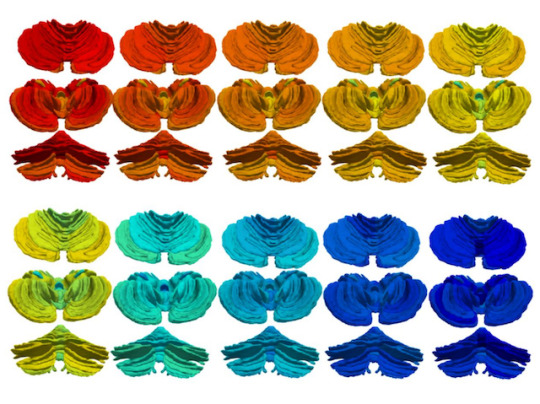
Baby Brains
The human body carries on developing after birth – but the rate of these changes is still in question for developmental biologists. Here scientists take magnetic resonance imaging (MRI) scans of sleeping children’s cerebellums over the first two years of life, showing months 1–5 (top row) and regular intervals afterwards (bottom) from three different angles. While the young brain is constantly growing, it’s growing at a faster rate (warmer colours) during the first six months. The researchers investigated further, analysing the scans from 235 healthy children and looking at how 27 individual regions of their cerebellums change – finding, for example, that changes in specific ‘lobules’ corresponded with milestones in fine motor skills. This data could be used to pinpoint developmental windows for further study, or even to diagnose health issues or injuries during a toddler’s early life.
Written by John Ankers
Image from work by Ya Wang and Liangjun Chen, and colleagues
Department of Radiology and Biomedical Research Imaging Center, University of North Carolina at Chapel Hill, Chapel Hill, NC, USA: UNC/UMN Baby Connectome Project Consortium
Image originally published with a Creative Commons Attribution 4.0 International (CC BY 4.0)
Published in Cell Reports, April 2023
You can also follow BPoD on Instagram, Twitter and Facebook
#science#biomedicine#brains#brain development#developmental biology#babies#brain#mri#magnetic resonance imaging#motor skills
6 notes
·
View notes
